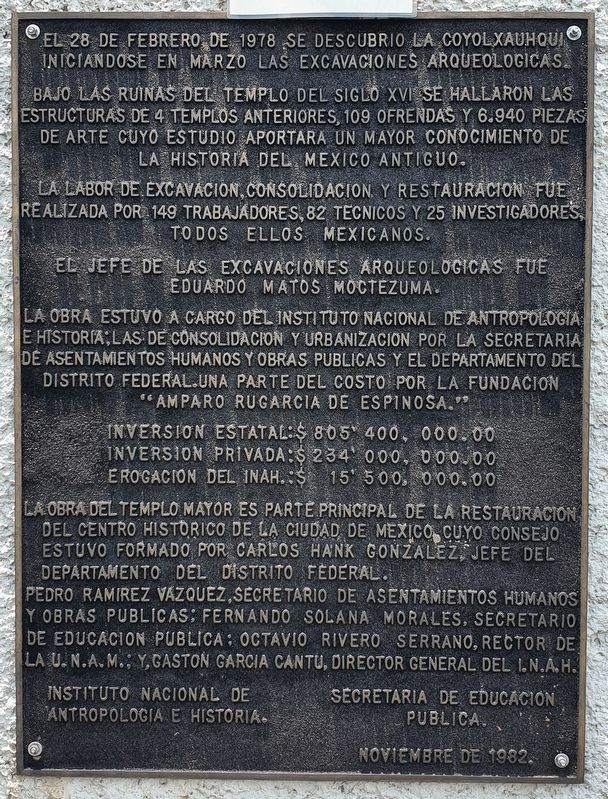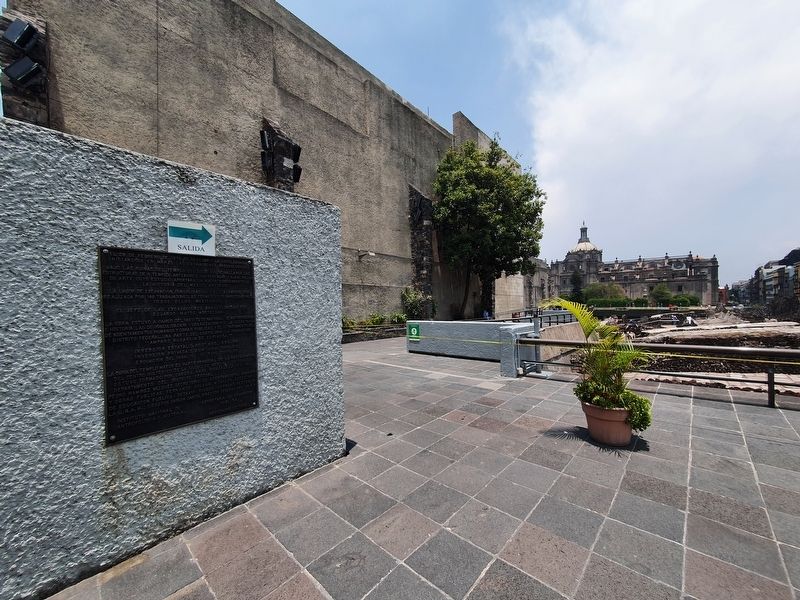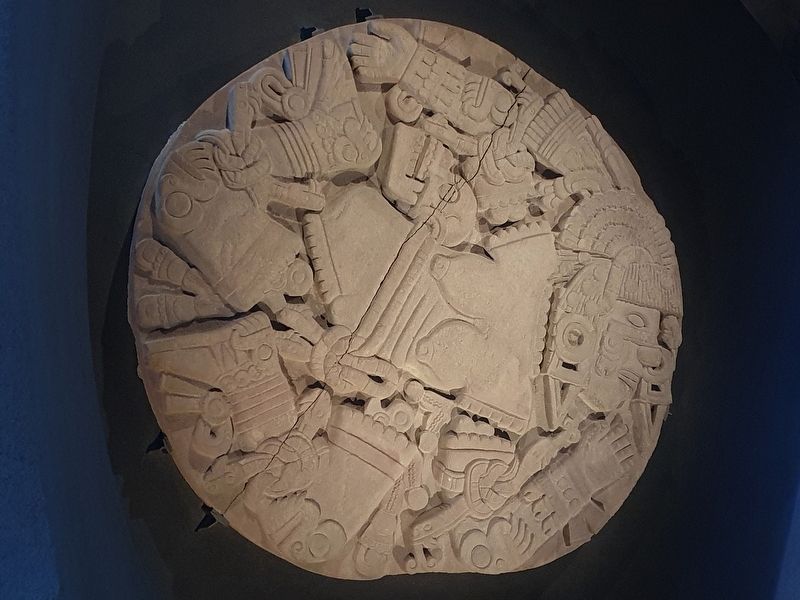Centro Histórico in Ciudad de México, Mexico — The Valley of Mexico (The Central Highlands)
Templo Mayor Museum
Bajo las ruinas del templo del siglo XVI se hallaron las estructuras de 4 templos anteriores, 109 ofrendas y 6,940 piezas de arte cuyo estudio aportara un mayor conocimiento de la historia del Mexico antiguo.
La labor de excavación, consolidación y restuaracion fue realizada por 149 trabajadores, 82 tecnicos y 25 investigadores, todos ellos mexicanos.
El jefe de las excavaciones arqueológicas fue Eduardo Matos Moctezuma.
La obra estuvo a cargo del Instituto Nacional de Antropologia e Historia; las de consolidación y urbanización por la Secretaria de Asentamientos Humanos y Obras Publicas y el Departamento del Distrito Federal. Una parte del costo por la Fundacion “Amparo Rugarcia de Espinosa.”
Inversion estatal: $805’400,000.00
Inversion privada: $234’000,000.00
Erogacion del INAH: $15’500,000.00
La obra del Templo Mayor es parte principal de la restuaracion del Centro Historico de la Ciudad de Mexico, cuyo consejo estuvo formado por Carlos Hank Gonzalez, Jefe del Departmento del Distrito Federal.
Pedro Ramirez Vazquez, Secretario de Asentamientos Humanos y Obras Publicas; Fernando Solana Morales, Secretario de Educacion Publica; Octavio Rivero Serrano, Rector de la U.N.A.M.; y, Gaston Garcia Cantu, Director General del I.N.A.H.
Instituto Nacional de Antropologia e Historia.
Secretaria de Educacion Publica.
Noviembre de 1982.
On February 28, 1978, the Coyolxuaqui was discovered, and archaeological excavations began in March.
Under the ruins of the sixteenth-century temple were found the structures of four previous temples, 109 offerings and 6,940 pieces of art whose study provided a greater knowledge of the history of ancient Mexico.
The excavation, consolidation and restoration work was carried out by 149 workers, 82 technicians and 25 researchers, all of them Mexican.
The head of the archaeological excavations was Eduardo Matos Moctezuma.
The work was in charge of the National Institute of Anthropology and History; those of consolidation and urbanization by the Secretariat of Human Settlements and Public Works and the Department of the Federal District. A part of the cost was covered by the Foundation "Amparo Rugarcia de Espinosa."
State investment: $805'400,000.00
Private investment: $234'000,000.00
INAH Expenditure: $15'500,000.00
The work of the Templo Mayor is a main part of the restoration of the Historic Center of Mexico City, whose council was formed by Carlos Hank Gonzalez, Head of the Department of the Federal District.
Pedro Ramirez Vazquez, Secretary of Human Settlements and Public Works; Fernando Solana Morales, Secretary of Public Education; Octavio Rivero Serrano, Rector of the U.N.A.M.; and, Gaston Garcia Cantu, General Director of the I.N.A.H.
National Institute of Anthropology and History.
Secretary of Public Education.
November 1982.
Erected 1982.
Topics. This historical marker is listed in this topic list: Anthropology & Archaeology. A significant historical date for this entry is February 28, 1978.
Location. 19° 26.088′ N, 99° 7.838′ W. Marker is in Ciudad de México. It is in Centro Histórico. Marker can be reached from Seminario just north of Plaza de la Constitución, on the right when traveling north. Touch for map. Marker is in this post office area: Ciudad de México 06000, Mexico. Touch for directions.
Other nearby markers. At least 8 other markers are within walking distance of this marker. Ocelotl-Cuauhxicalli (within shouting distance of this marker); Eastern Border of the Sacred Center (within shouting distance of this marker); Commemorative Dates in the Great Temple (within shouting distance of this marker); Offering 17 (within shouting distance of this marker); The Tláloc Braziers
(within shouting distance of this marker); Colonial Arch and Platform from Phase V (within shouting distance of this marker); Palacio de la Autonomía (within shouting distance of this marker); Ex Teresa Arte Actual (within shouting distance of this marker). Touch for a list and map of all markers in Ciudad de México.
Also see . . . Coyolxauhqui at Wikipedia. (Submitted on September 28, 2022.)
Credits. This page was last revised on September 28, 2022. It was originally submitted on September 27, 2022, by J. Makali Bruton of Accra, Ghana. This page has been viewed 73 times since then and 10 times this year. Photos: 1, 2, 3. submitted on September 28, 2022, by J. Makali Bruton of Accra, Ghana.


